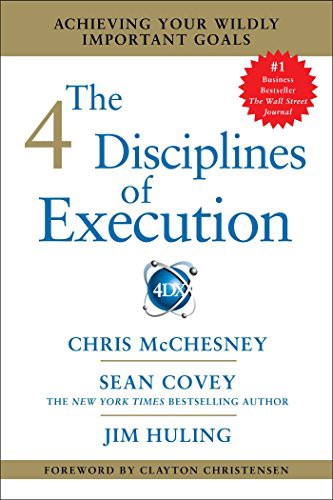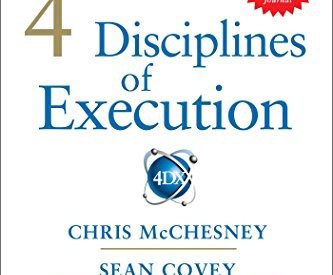My favorite business books are based on hard-won experience.
The ones where the authors have refined their ideas through years of teaching and training ? they know what really works and where the pitfalls lie.
The Four Disciplines of Execution* by Chris McChesney, Sean Covey and Jim Huling is one of the best. A simple (but not easy) framework for ensuring that the most important work gets done, and battle-tested in over a thousand consulting engagements.
A true classic, as relevant for personal life as it is essential for business.
Classic Business Book Summary and Review
In 1961 the US was losing the space race. The Russians had launched Sputnik, Laika, and Yuri Gagarin beyond the atmosphere.
Despite strong investment and talent, the National Aeronautics and Space Administration was behind. This changed when President Kennedy set NASA a new challenge.
?I believe that this nation should commit itself to achieving the goal, before this decade is out, of landing a man on the moon and returning him safely to the earth.?
John F. Kennedy
Up until this point, NASA had several lofty goals it was pursuing, for example: ?The expansion of human knowledge of phenomena in the atmosphere and space.?
The audacious challenge set by President Kennedy gave them a more specific rallying cry. Unlike their previous goals, this one was easy to remember, easy to track and had a clear deadline. The rest, as they say, is history.
The Four Disciplines of Execution (4DX) Summary
Most executives lament their organization?s inability to follow through on its biggest goals.
4DX attempts to tackle this ?strategy/execution gap.? The gap occurs for any goal that needs behavioral change.
The biggest reason people fail to execute on goals is ?the whirlwind.?
The whirlwind is the day job; it?s the things that must get done to run the business. It destroys the execution of larger goals. It wins when the organization has too many goals, the goals are unclear, and/or there is no accountability for achieving the goals.
Discipline One: Focus on the Wildly Important.
Pick one critical goal (or at the most two.) This is your Wildly Important Goal or WIG. It?s very difficult for most ambitious leaders to focus on only one goal, but this concentration of forces is necessary to defeat the whirlwind (bonus: the process of choosing a WIG often sharpens strategy.) Staff still need to spend 80% of their time and effort on the day-to-day, but 20% should be focused on the WIG. Once a WIG is achieved, it becomes habit and goes back into the whirlwind.
To pick a WIG, brainstorm all possible goals with your team. The WIG tends to be better when more creative possibilities are gathered. A good question to ask is: ?Which one area of our team?s performance would we want to improve most (assuming everything else holds) in order to achieve the overall WIG of the organization?? Then rank the choices by impact and create a shortlist. Test each WIG on the shortlist for how it will affect the overall goals of the organization, whether it can be measured effectively, and if the team has control over the results. Define the final choice simply: ?We will go from here to there by this date.? Finally, make sure that the WIG is challenging, but achievable ? if you would privately be happy with getting to 70%, it?s too hard. Remember, you are trying to create a game the team can win if they rise to their potential.
How to: Rules for WIGs
- Rule #1: No team focuses on more than two WIGs at a time.
- Rule #2: The battles chosen must win the war. WIGs lower in the organization must serve to achieve the WIGs at the top of the organization.
- Rule #3: Senior leadership can?t set the lower-level WIGs but they can veto. People need to be involved in the setting of the goals to be engaged in the achieving of them.
- Rule #4: All WIGs should be in the form of going from X to Y by a certain date (see Kennedy?s challenge above).
Discipline Two: Act on the Lead Measures
The second discipline is to focus on the activities that drive results. There are two types of measures.
Lag measures describe results ? what you are trying to achieve (revenue, profit, market share.) Your WIG is a lag measure. You can?t ?do? lag measures, and they arrive too late. Lag measures are tricky, because any lack of clarity about what a team member should be doing is a victory for the whirlwind.
Lead measures describe activities or sub-goals which can be acted upon. A good lead measure predicts success on the lag measure, and the team has direct influence over it ? it?s not dependent on another team. The team should choose their own lead measures by selecting activities that will have the most impact on achieving the WIG.
Getting lead measures right is essential for successful execution.
To choose good lead measures, gather the team again and brainstorm. Ask: ?What could we do that we?ve never done before that might make all the difference to the WIG?? You will find two main types of lead measures: small outcomes and leveraged behaviors.
Small outcomes focus on a weekly result ? with flexibility on how the team achieves it. Leveraged behaviors track specific activities.
Rank by impact and create a shortlist. Only pick a few. Then test the shortlist. Is it predictive? influenceable? measurable? Define the measure simply and clearly. Are you tracking the team or the individual? How frequently?
Discipline Three: Keep a Compelling Scoreboard
To remain engaged, the team should know at all times if they are winning. People play more seriously when they are keeping score. Without knowing the score, staff will be distracted by the whirlwind. A visible scoreboard helps the team to work out how to move forward.
There is a big difference between a manager?s scoreboard and a team?s scoreboard. The team?s scoreboard should be simple, visible, show both lead and lag measures (actions and results), and show at-a-glance if the team is winning. It can be motivating for the team to physically create their own board.
Pro Tip: Ensure that there is a bullet-proof way to update the scoreboard.
The aim is to create a winnable game for the team; one that plays out every day. The feeling of winning, has the most powerful effect on morale and engagement ? and it?s something the whirlwind does not provide well.
Discipline Four: Create a Cadence of Accountability
The first three disciplines prepare for the game; the fourth discipline is the game itself ? it is execution. Each team responsible for a WIG meets at least weekly in a WIG session. The aim of the WIG session is to hold team members personally accountable, clear the path ahead, solve problems, and commit to actions for the next week.
There are two unalterable rules for a WIG session to be successful. First, the session is held at the same time every time, at least weekly. The meeting is sacrosanct. Second, the whirlwind is not allowed in-no matter how urgent the issue.
How to: Run a WIG Session
WIG sessions are fast-paced, typically 20?30 minutes and have the same agenda:
- Account: Report on individual commitments made the previous session
- Review the scoreboard: Learn and problem-solve
- Plan: Make new commitments.
Each commitment made must be a specific deliverable ? not a commitment to ?work on? something. Each commitment must aim to move the lead measure. A good question each team member can ask is ?What are the one or two most important things I can do this week to impact the team?s performance on the scoreboard?? All commitments are personal commitments and need to be completed within a week.
Managers will likely be in two WIG sessions a week, one they lead, and one led by their manager. Frontline teams, such as those in an Emergency Department may need to create a shorter weekly WIG huddle.
The WIG sessions are like experiments where the team tries new ideas and activities and reports back. The level of importance and consistent focus the leadership puts on the WIG sessions determines their effectiveness. That and the fact that people create their own commitments. For many proponents of 4DX the lead measure for success overall is attendance and consistency of WIG sessions.
Common pitfalls
- Don?t mistake whirlwind tasks for WIG commitments. Ask whether the commitment will impact the scoreboard.
- Make sure each session has a clear commitment and that they aren?t the same week after week.
- If someone hasn?t met their commitment:
- Demonstrate respect.
- Reinforce accountability. Don?t accept unfulfilled commitments
- Encourage performance.
?Finally, remember that the four rules of focus are unforgiving. At some point, you will want to cheat on them, even just a little. We know. We often want to do the same inside our organization. However, what we?ve learned is that the rules governing focus are like the rules governing gravity: They aren?t concerned with what you think or with the details of your particular situation. They simply yield predictable consequences.?
Review
4DX is one of my favorite business books, and one I turn to often. While deceptively simple, it offers a clear framework for solving a critical leadership challenge. This was the consistent problem health systems faced in across decades of research. Not: What strategy? but, how do we get it done? How do we create behavioral change?
What I find particularly compelling is that the insights are hard-won. The framework was tested and perfected through more than 1500 consulting engagements. You can see that in the practical detail on how to execute the strategies within the book. These ideas are battle-tested. The book, like most business books suffers a little from repetitiveness. The authors have organized it in an iterative structure, with the disciplines summarized, then repeated with more detail, then repeated again with implementation guidance. But there is less padding than most books of the genre and they do a good job answering likely questions and sharing examples and case studies. An essential, straightforward, tactical book that could transform an organization. Highly recommended.

You can pick up a copy of 4DX here.*
One of the authors, Chris McChesney has a nice short video summary here.
If you’d like to keep up to date with my writing ? sign up for my newsletter.
Quick summary of the four disciplines
The four disciplines are designed to beat the ?Whirlwind? ? the day to day business that crowds out action on strategic initiatives. After implementing the four disciplines staff will still spend 80% of their time on the whirlwind ? but 20% will be focused on strategic execution.
Discipline 1: Focus on the Wildly Important.
Select one, (or at the most two) critical goals at a time. This goal is called your Wildly Important Goal (WIG). This narrowing of focus is essential to ensure that the goal is achieved. WIGs should simple, vital and expressed in the form ? ?change from X to Y in a specific time period.?
Discipline Two: Act on the Lead Measures
Focus on the activities that drive results. Lag measures describe results, what you are trying to achieve ? revenue, profit, market share. Achieving your WIG is a lag measure. Lead measures describe activities or sub-goals which can be acted upon. A good lead measure predicts success on the lag measure, and the team has direct influence over it ? it?s not dependent on another team.
Discipline 3: Keep a Compelling Scoreboard
To remain engaged, the team should know at all times if they are winning. A visible scoreboard helps the team to work out how to move forward.
Discipline 4: Create a Cadence of Accountability
The first three disciplines are preparation; the fourth discipline is execution. Each team responsible for a WIG meets at least weekly in a ?WIG session?. At each short session, the team reviews their commitments from the previous session, checks the scoreboard, and makes new, specific personal commitments for the next session.
There are two unalterable rules for a WIG session to be successful. First, the session is held at the same time every time, at least weekly. The meeting is sacrosanct. Second, the whirlwind is not allowed in, no matter how urgent the issue.
* Affiliate link


